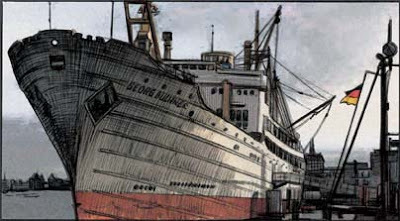Werd de Charlesville opzettelijk tot zinken gebracht?
De voormalige Antwerpse Congoboot Charlesville is in de nacht van 30 op 31 mei in verdachte omstandigheden gezonken in de Baltische Zee, voor de Poolse kust. Dat concludeert de Vlaamse Vereniging voor Industriële Archeologie (VVIA). Kostbare stukken waren in de voorbije weken uit het schip verdwenen. Er bestaat een reële kans dat het om verzekeringsfraude gaat. In Duitsland zijn de laatste tijd verschillende soortgelijke schandalen aan het licht gekomen. Het schip was het laatste overblijvende voormalige passagiersschip dat Antwerpen met Congo verbond. De Charlesville werd gebouwd in 1951 door John Cockeril in Hoboken in opdracht van de Compagnie Maritime Belge. Het was één van de vijf zusterschepen die de verbinding met de toenmalige kolonie Belgisch Congo moesten waarborgen. De andere schepen waren de Albertville, de Leopoldville, de Elisabethville en de Baudouinville. Een rondreis duurde gemiddeld een maand. De schepen maakten een tussenstop in Tenerife en Lobito (Angola) op de terugreis deden ze Boma en Matadi aan. Met het zinken van het schip verdwijnt een onvervalst stuk Belgisch patrimonium in duistere omstandigheden.
The former Antwerp Congo Boat Charlesville sank on the night of 30 on May 31 in suspicious circumstances in the Baltic Sea, off the Polish coast. That concludes the Flemish Association for Industrial Archaeology (VVIA). Precious pieces disappeared in previous weeks from the ship. There is a realistic probability that it's a case of insurance fraud. In recent years several similar scandals came to light in Germany. The passenger ship was the last remaining connection from Antwerp to Congo. The Charlesville was built in 1951 by John Cockerill in Hoboken commissioned by the Compagnie Maritime Belge. It was one of five sister ships that had to ensure the connection to the former Belgian colony Congo. The other ships were the Albertville, the Leopoldville, the Elisabethville and the Baudouinville. A tour lasted approximately one month. The ship made a stop in Tenerife and Lobito (Angola) and on the return passed Boma and Matadi. With the sinking of the ship a genuine piece of Belgian heritage disappeared in dark circumstances.
L'ancien Anvers Congo Bateau Charlesville a coulé dans la nuit du 30 au 31 mai dans des circonstances suspectes dans la mer Baltique, au large de la côte polonaise. Voilà qui conclut l'Association flamande pour l'archéologie industrielle (VVIA). Pièces précieuses ont disparu dans les semaines précédentes du navire. Il y a une probabilité réaliste que c'est un cas de fraude à l'assurance. Au cours des dernières années, plusieurs scandales similaires ont émergé en Allemagne. Le Navire à passagers était le dernier lien qui reste d'Anvers au Congo. Le Charlesville a été construit en 1951 par John Cockerill à Hoboken commandée par le Belge Maritime Compagnie. Il était l'un des cinq navires jumeaux qui devaient assurer la liaison avec l'ancienne colonie belge du Congo. Les autres navires étaient l'Albertville, le Léopoldville, l' Elisabethville et le Baudouinville. Un voyage a duré environ un mois. Le navire a fait escale à Tenerife et Lobito (Angola) et sur le retour passait Boma et Matadi. Avec le naufrage du navire une véritable morceau de patrimoine belge a disparu dans des circonstances mystérieux. Nog een waterkans voor Congoboot Charlesville
Nog een waterkans voor Congoboot Charlesville
The former Antwerp Congo Boat Charlesville sank on the night of 30 on May 31 in suspicious circumstances in the Baltic Sea, off the Polish coast. That concludes the Flemish Association for Industrial Archaeology (VVIA). Precious pieces disappeared in previous weeks from the ship. There is a realistic probability that it's a case of insurance fraud. In recent years several similar scandals came to light in Germany. The passenger ship was the last remaining connection from Antwerp to Congo. The Charlesville was built in 1951 by John Cockerill in Hoboken commissioned by the Compagnie Maritime Belge. It was one of five sister ships that had to ensure the connection to the former Belgian colony Congo. The other ships were the Albertville, the Leopoldville, the Elisabethville and the Baudouinville. A tour lasted approximately one month. The ship made a stop in Tenerife and Lobito (Angola) and on the return passed Boma and Matadi. With the sinking of the ship a genuine piece of Belgian heritage disappeared in dark circumstances.
L'ancien Anvers Congo Bateau Charlesville a coulé dans la nuit du 30 au 31 mai dans des circonstances suspectes dans la mer Baltique, au large de la côte polonaise. Voilà qui conclut l'Association flamande pour l'archéologie industrielle (VVIA). Pièces précieuses ont disparu dans les semaines précédentes du navire. Il y a une probabilité réaliste que c'est un cas de fraude à l'assurance. Au cours des dernières années, plusieurs scandales similaires ont émergé en Allemagne. Le Navire à passagers était le dernier lien qui reste d'Anvers au Congo. Le Charlesville a été construit en 1951 par John Cockerill à Hoboken commandée par le Belge Maritime Compagnie. Il était l'un des cinq navires jumeaux qui devaient assurer la liaison avec l'ancienne colonie belge du Congo. Les autres navires étaient l'Albertville, le Léopoldville, l' Elisabethville et le Baudouinville. Un voyage a duré environ un mois. Le navire a fait escale à Tenerife et Lobito (Angola) et sur le retour passait Boma et Matadi. Avec le naufrage du navire une véritable morceau de patrimoine belge a disparu dans des circonstances mystérieux.
 Nog een waterkans voor Congoboot Charlesville
Nog een waterkans voor Congoboot Charlesville
Published on June 01, 2013 12:16
No comments have been added yet.
Marc Verhaegen's Blog
Marc Verhaegen isn't a Goodreads Author
(yet),
but they
do have a blog,
so here are some recent posts imported from
their feed.



